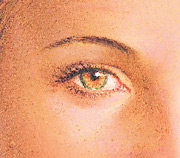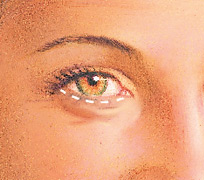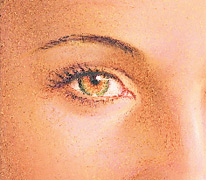Eyelid surgery, called blepharoplasty, is a surgical procedure to improve the appearance of the eyelids. Surgery can be performed on either the upper and lower lids, or both. Whether you want to improve your appearance or are experiencing functional problems with your eyelids, eyelid surgery can rejuvenate the area surrounding your eyes.
The appearance of a drooping upper lid may also be due to relaxation of the forehead skin and eyebrow. Sometimes a drooping eyelid is caused by stretching of one of the upper eyelid muscles, the levator. Your plastic surgeon will evaluate your anatomy thoroughly to determine the causes of your eyelid appearance, and what procedures might best remedy them.
Specifically, eyelid surgery can treat:
- Loose or sagging skin that creates folds or disturbs the natural contour of the upper eyelid, sometimes impairing vision
- Excess fatty deposits that appear as puffiness in the eyelids
- Bags under the eyes
- Drooping lower eyelids that reveal white below the iris
- Excess skin and fine wrinkles of the lower eyelid Upper eyelid surgery can remove excess fatty deposits that appear as puffiness in the upper eyelids.
Is it right for me?
A blepharoplasty procedure is usually performed on adult men and women who have healthy facial tissue and muscles and have realistic goals for improvement of the upper and/or lower eyelids and surrounding area.
You should undergo blepharoplasty surgery for yourself, not to fulfill someone else’s desires or to try to fit any sort of ideal image.
Good candidates for cosmetic eyelid surgery are:
- Healthy individuals who do not have a life-threatening illness or medical conditions that can impair healing
- Non-smokers
- Individuals with a positive outlook and specific goals in mind for blepharoplasty
- Individuals without serious eye conditions
You must tell your doctor if you have any of these medical conditions:
- Eye disease such as glaucoma, dry eye or a detached retina
- Thyroid disorders such as Graves’ disease and under or overactive thyroid
- Cardiovascular disease, high blood pressure or other circulatory disorders or diabetes
Eyelid surgery at a glance
215,641 people had eyelid surgery in 2013.
| Age | |
| 13-19 | 1% |
| 20-39 | 9% |
| 40-55+ | 90% |
| Gender | |
| Males | 15% |
| Females | 85% |
The success and safety of your eyelid surgery procedure depends very much on your complete candidness during your cosmetic eyelid surgery consultation. You’ll be asked a number of questions about your health, desires and lifestyle.
.jpg) Be prepared to discuss:
Be prepared to discuss:
- Why you want the surgery, your expectations and desired outcome
- Medical conditions, drug allergies and previous medical treatments
- Use of current medications, vitamins, herbal supplements, alcohol, tobacco and drugs
- Previous surgeries
Your surgeon may also:
- Evaluate your general health status and any pre-existing health conditions or risk factors
- Take photographs for your medical record
- Discuss your options and recommend a course of treatment
- Discuss likely outcomes of eyelid surgery and any risks or potential complications
- Discuss the type of anesthesia that will be used
.jpg) Before blepharoplasty surgery, you may be asked to:
Before blepharoplasty surgery, you may be asked to:
- Get lab testing or a medical evaluation
- Take certain medications or adjust your current medications
- Stop smoking well in advance of surgery
- Avoid taking aspirin, anti-inflammatory drugs and herbal supplements as they can increase bleeding
Special instructions you receive will cover:
- What to do on the night before and the morning of surgery
- The use of anesthesia during your procedure
- Post-operative care and follow-up
Your plastic surgeon will also discuss where your procedure will be performed.
You’ll need help
Eyelid surgery may be performed in an accredited office-based surgical facility, outpatient or licensed ambulatory surgical center, or a hospital. Be sure to arrange for someone to drive you to and from surgery and to stay with you for at least the first night following surgery.
What happens during an eyelid surgery?

Step 1 – Anesthesia
Medications are administered for your comfort during the eyelid surgery procedure. The choices include intravenous sedation or general anesthesia. Your doctor will recommend the best choice for you.
Step 2 – The incision
The incision lines for eyelid surgery are designed for scars to be well concealed within the natural structures of the eyelid region.
Droopy conditions of the upper eyelid can be corrected through an incision within the natural crease of the upper eyelid allowing repositioning of fat deposits, tightening of muscles and tissue, and/or removal of excess skin.
.jpg)
.jpg)

Conditions of the lower eyelid may be corrected with an incision just below the lower lash line. Through this incision, excess skin in the lower eyelids is removed.
A transconjunctival incision, one hidden inside the lower eyelid, is an alternate technique to correct lower eyelid conditions and redistribute or remove excess fat.


Step 3 – Closing the incisions
Eyelid incisions typically are closed with:
- Removable or absorbable sutures
- Skin adhesives
- Surgical tape
Your surgeon may use a laser chemical peel to erase dark discoloration of the lower eyelids.
Step 4 – See the results
The results of eyelid surgery will appear gradually as swelling and bruising subside to reveal a smooth, better-defined eyelid and surrounding region, and an alert and rejuvenated appearance.

The decision to have eyelid surgery is personal, and you’ll have to decide if this surgery will achieve your goals, and if the potential risks are acceptable. Be sure you understand the surgery and recuperation completely, and don’t hesitate to ask your plastic surgeon questions.
Your plastic surgeon and/or staff will explain potential eyelid surgery complications in detail. These risks and others will be fully discussed prior to your consent. It is important that you address all your questions directly with your plastic surgeon.
- Anesthesia risks
- Swelling and bruising
- Bleeding from the incision lines
- Dryness to the eyes
- Sensitivity to sun or other bright light
- Difficulty closing your eyes
- Ectropion, an outward rolling of the eyelid
- Infection
- Lid lag, a pulling down of the lower eyelid may occur and is often temporary
- Temporary or even permanent change in vision, and very rare chance of blindness
- Changes in skin sensation
- Pain, which may persist
- Poor wound healing
- Possible need for revision surgery
- Unfavorable scarring
Be sure to ask questions:
It’s very important to ask your plastic surgeon questions about your eyelid procedure. It’s natural to feel some anxiety, whether it’s excitement for your anticipated new look or a bit of preoperative stress. Don’t be shy about discussing these feelings with your plastic surgeon.
A special note about the use of fibrin sealants (tissue glue)
Fibrin sealants (made from heat-treated human blood components to inactivate virus transmission) are used to hold tissue layers together at surgery and to diminish post-operative bruising following surgery.
This product has been carefully produced from screened donor blood plasma for hepatitis, syphilis, and human immunodeficiency virus (HIV). These products have been used safely for many years as sealants in cardiovascular and general surgery. This product is thought to be of help in diminishing surgical bleeding and by adhering layers of tissue together.
When you go home
If you experience shortness of breath, chest pains, or unusual heart beats, seek medical attention immediately. Should any of these complications occur, you may require hospitalization and additional treatment.
The practice of medicine and surgery is not an exact science. Although good results are expected, there is no guarantee. In some situations, it may not be possible to achieve optimal results with a single surgical procedure. Another surgery may be necessary.
Be careful
Following your physician’s instructions is key to the success of your surgery. It is important that the surgical incisions are not subjected to excessive force, abrasion or motion during the time of healing. Your doctor will give you specific instructions on how to care for yourself.
.jpg) After your procedure is completed, lubricating ointment and cold compresses may be applied, and in some cases your eyes may be loosely covered with gauze.
After your procedure is completed, lubricating ointment and cold compresses may be applied, and in some cases your eyes may be loosely covered with gauze.
You will be given specific instructions that may include how to care for your eyes, medications to apply or take orally to aid healing and reduce the potential for infection, specific concerns to look for at the surgical site or in your overall health, and when to follow-up with
your plastic surgeon.
Initial healing may include some swelling, bruising, irritation or dry eyes, and discomfort that can be controlled with medication, cold compresses, and ointment. Irritation at the incision sites is also possible. Be sure to ask your plastic surgeon specific questions about what you can expect during your individual recovery period.
- Where will I be taken after my surgery is complete?
- What medication will I be given or prescribed after surgery?
- Will I have dressings/bandages after surgery?
- When will they be removed?
- Are stitches removed? When?
- When can I resume normal activity and exercise?
- When do I return for follow-up care?
A special note: You must practice diligent sun protection and use darkly tinted sunglasses until the healing process is fully complete.
.jpg) The results of eyelid surgery will be long-lasting. Your final results will appear within several weeks, but it may take up to a year for incision lines to fully refine. While eyelid surgery can be expected to correct certain conditions permanently, you will continue to age naturally. Life-long sun protection will help to maintain your results. Satisfaction with your new image should continue to grow as you recover from surgery. As swelling and bruising subside, the results of eyelid surgery will reveal a smooth, better-defined eyelid and surrounding region and an alert and rejuvenated appearance.
The results of eyelid surgery will be long-lasting. Your final results will appear within several weeks, but it may take up to a year for incision lines to fully refine. While eyelid surgery can be expected to correct certain conditions permanently, you will continue to age naturally. Life-long sun protection will help to maintain your results. Satisfaction with your new image should continue to grow as you recover from surgery. As swelling and bruising subside, the results of eyelid surgery will reveal a smooth, better-defined eyelid and surrounding region and an alert and rejuvenated appearance.
Although good results are expected from your procedure, there is no guarantee. In some situations, it may not be possible to achieve optimal results with a single surgical procedure and another surgery may be necessary.
 Cost is always a consideration in elective surgery. The cost of eyelid surgery can vary widely. A surgeon’s blepharoplasty cost may vary based on his or her experience, the type of procedure used, as well as geographic office location.
Cost is always a consideration in elective surgery. The cost of eyelid surgery can vary widely. A surgeon’s blepharoplasty cost may vary based on his or her experience, the type of procedure used, as well as geographic office location.
Many plastic surgeons offer patient financing plans, so be sure to ask.
The cost of blepharoplasty surgery may include:
- Surgeon’s fee
- Hospital or surgical facility costs
- Anesthesia fees
- Prescriptions for medication, and
- Medical tests
Your satisfaction involves more than a fee
When choosing a plastic surgeon for eyelid surgery, remember that the surgeon’s experience and your comfort with him or her are just as important as the final cost of the surgery.
Most health insurance does not cover cosmetic surgery or its complications. When eyelid surgery is performed to eliminate the redundant skin covering the eyelashes, it may be covered by insurance. Carefully review your policy.
- Blepharoplasty: Eyelid surgery to improve the appearance of upper eyelids, lower eyelids or both
- Ectropion: When the lower eyelid is rolled outward after eyelid surgery; often a temporary condition.
- General anesthesia: Drugs and/or gases used during an operation to relieve pain and alter consciousness.
- Hematoma: Blood pooling beneath the skin.
- Intravenous sedation: Sedatives administered by injection into a vein to help you relax.
- Local anesthesia: A drug injected directly to the site of an incision during an operation to relieve pain.
- Transconjunctival incision: Incision hidden inside the lower eyelid.
- Skin resurfacing: Treatment to improve the texture, clarity and overall appearance of your skin.
- Sutures: Stitches used by surgeons to hold skin and tissue together.
Use this checklist of eyelid surgery questions during your consultation.
- Are you certified by the American Board of Plastic Surgery?
- Are you a member of the American Society of Plastic Surgeons?
- Were you trained specifically in the field of plastic surgery?
- How many years of plastic surgery training have you had?
- Do you have hospital privileges to perform this procedure? If so, at which hospitals?
- Is the office-based surgical facility accredited by a nationally or state-recognized accrediting agency, or is it state-licensed or Medicare-certified?
- Am I a good candidate for this procedure?
- What will be expected of me to get the best results?
- Where and how will you perform my procedure?
- What surgical technique is recommended for me?
- How long of a recovery period can I expect and what kind of help will I need during my recovery?
- What are the risks and complications associated with my procedure?
- How are complications handled?
- How can I expect my eyes to look over time?
- What are my options if I am dissatisfied with the cosmetic outcome of my eyelid surgery?
- Do you have before-and-after photos I can look at for this procedure and what results are reasonable for me?
Plastic surgery involves many choices.
The first and most important is selecting a surgeon you can trust.
Choosing an ASPS Member Surgeon ensures that you have selected a physician who:
- Has completed at least five years of surgical training with a minimum of two years in plastic surgery.
- Is trained and experienced in all plastic surgery procedures, including breast, body, face and reconstruction.
- Operates only in accredited medical facilities.
- Adheres to a strict code of ethics.
- Fulfills continuing medical education requirements, including standards and innovations in patient safety.
- Is board certified by The American Board of Plastic Surgery or in Canada by the Royal College of Physicians and Surgeons of Canada®.
ASPS Member Surgeons are your partners in cosmetic and reconstructive plastic surgery.
Look for the ASPS Member Surgeon logo.

 3510 N. Ridge Rd, Suite 100
3510 N. Ridge Rd, Suite 100